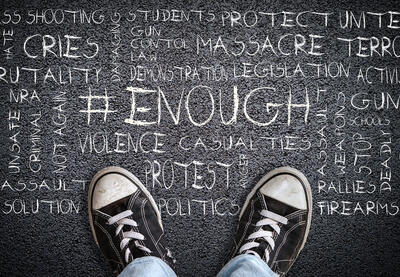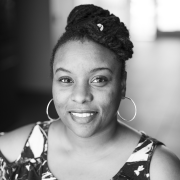Just over a month ago, 19 children and two teachers were murdered in their elementary classrooms in Uvalde, Texas. That happened before we had time to grapple with the racist, targeted murders of 10 people in a Buffalo, New York, grocery store. In the days after the two shootings, more incidents of gun violence happened across the country, including in Philadelphia, Pennsylvania, and Tulsa, Oklahoma. And most recently, a mass shooter killed seven people and injured dozens of others at a Fourth of July parade in Highland Park, Illinois. The fact that citizens aren’t safe at an event meant to celebrate the nation’s founding is proof that we’re far from being a place where justice and freedom are realized.
Yet, it feels as though these incredibly traumatizing events become blips in the American news cycle and we barely have time to grieve between incidents. Then, too often, grief and outrage quickly dissipate until the next mass shooting happens.
Over the last two decades, discourse about gun violence has always ebbed and flowed. But for change to happen, anti-gun violence advocacy has to stay top of mind.
Young people are leading this movement—but they shouldn’t be in this fight alone. As of this writing, the United States has experienced at least 300 mass shootings, including 27 school shootings so far this year. We’re only halfway into 2022.
Gun violence at schools—where young people are supposed to feel safe—has become a regular part of our culture. From Columbine and Newtown to Parkland and Uvalde, we have yet to truly tackle our problem with guns. According to The Washington Post data, more than 311,000 students have experienced gun violence since the 1999 Columbine High School shooting. We can’t continue to normalize this phenomenon. We can’t become numb to this.
Feel Their Anger
Many people are justifiably more cautious in their daily, mundane activities, as elected officials act slowly—or not at all—to address Americans’ penchant for guns and violence. And that cautiousness is for good reason.
For example, during the recent student-led March for Our Lives rally in Washington, D.C., a man charged the stage to disrupt the large gathering during a moment of prayer. When security restrained him, an audio speaker fell, creating a loud pop. Many in the crowd attempted to flee the area, as they thought they, too, would become victims of yet another mass shooting.
We’re on edge. That’s not freedom. Enough is enough.
Along with collective anxiety, anger is bubbling up among young people. We need to feel their anger. Activists, survivors and parents of victims of mass shootings spoke of that anger at the recent March for Our Lives event. And they contend that this movement, this time, feels different.
Young people aren’t accepting that the risk of gun violence remains the status quo—nor should they. They aren’t moved by pleas to interpret the Second Amendment as justification to own—and secure without restrictions—military-style weapons.
At the event, David Hogg, who survived a deadly shooting in 2018 at Marjorie Stoneman Douglas High School in Parkland, Florida, explicitly described why we should be horrified by the harm caused by assault weapons to children’s bodies like in Uvalde, Texas, and stressed that we must demand more change.
“I don’t want anybody to live this nightmare anymore,” Hogg said. “No matter your politics, no one should. … Rights are power and with power comes responsibility. All Americans have a right to not be shot—a right to safety. Nowhere, nowhere in the Constitution is unrestricted access to weapons of war a guaranteed right.”
So What About Chicago?
Racism and other types of discrimination are often linked to discourse about guns. Young people are paying attention. Following a press conference in Uvalde, Texas, Gov. Greg Abbott evoked Chicago to deflect from discussing gun restrictions. He viewed the Uvalde, Texas, shooting as an exception, while claiming Chicago shootings are the norm—a common racist refrain.
“I hate to say this, but there are more people shot every weekend in Chicago than there are in schools in Texas,” Abbott said. “We need to realize that people who think that ‘well, maybe if we just implement tougher gun laws, it’s gonna solve it.’ Chicago and LA and New York disprove that thesis.”
But one state’s laws often do not impact what happens in neighboring states. According to a 2017 gun tracing report, 60% of illegally used or possessed guns recovered in Chicago are traced back to states with less regulation over guns.
“So-called strict gun laws we supposedly have mean nothing if the states around us have lax gun laws,” said Trevon Bosely, a Chicago teen, who was among the speakers at the recent March for Our Lives rally.
It’s important for us all to understand the context of where and how gun violence occurs. The truth is, Illinois and Texas have similar gun deaths per capita, according to CDC data. And gun homicides are most prominent in communities that experience disinvestment and neglect. The pandemic exposed these inequities. During his speech, Bosley made those connections between systemic failures and an environment prone to gun violence in his city.
“I’m speaking for … places where COVID-19 was not our first introduction to mass death and overcrowded hospitals,” he said. “You know, the places where poverty rates are already high and living paycheck to paycheck is the norm. Communities where school systems are underfunded, and state penitentiaries are overfilled; where politicians are overpaid, and anti-violence programs are under-resourced; where police officers are overtly racist and our so-called justice system rarely holds them accountable; places where, you know, where all lives supposedly matter but Black and Brown lives are taken on a daily basis.”
A Call to Action
Anti-gun violence advocates say there are numerous ways to counter gun violence but adding more guns isn’t one of them. As we pointed out in “School Safety and Guns Don’t Mix,” armed police at schools have not stopped the carnage and cause even more harm.
Teachers and students have agreed they don’t want teachers to carry guns at school. From the fear of accidental shootings to targeting students of color due to the implicit bias of educators, communities have warned that armed educators won’t make them feel safer.
Nonetheless, lawmakers continue to draft bills to do just that. Ohio and Louisiana are among the latest states to consider such laws since the Uvalde, Texas, murders.
What We Can Do
- Petition for more stringent gun laws such as universal background checks.
- Contact congresspersons to urge them to take action.
- Raise funds to help activists, including youth activists, grow the anti-gun violence movement.
- Support groups working to decriminalize students at schools and who advocate for counseling and mental health care services instead.
- Support students who rally, strike or campaign against gun violence.

